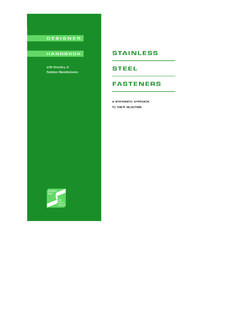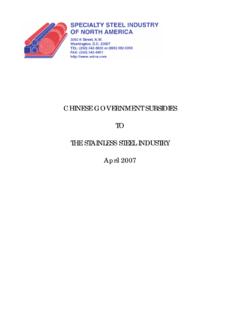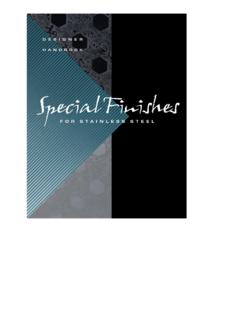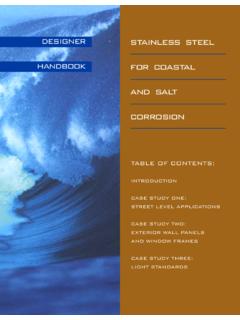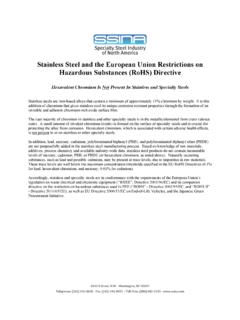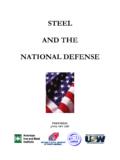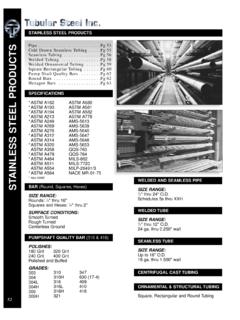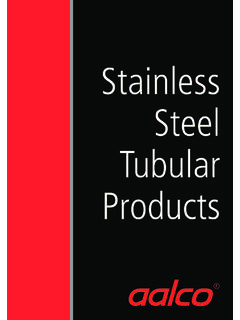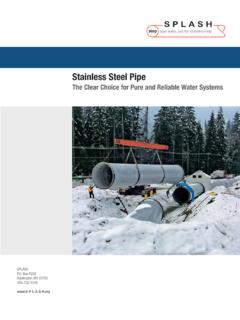Transcription of CLEANING OF STAINLESS STEEL - ssina.com
1 HANDBOOKDESIGNERTHE CARE ANDCLEANINGOF STAINLESS STEELS tainlessSteelTheValueOption 71027 SS Care& CLEANING l/o 6/15/01 2:10 PM Page 2 INClecloseacthe phastai(roostaiof cto psurfperis eto cTpradurinclconthatmetgensurfhanTthatcle ametare usewithreqappTABLE OF CONTENTSINTRODUCTION ..1 WHAT IS STAINLESS STEEL ..1 ALLOY TYPES ..1 FORMS AND FINISHES ..2 CLEANING OF STAINLESS STEEL ..3 Types of surface contaminants ..3 TYPES OF CLEANERS AND METHODS ..4 EFFECTIVE CLEANING METHODS ..5 CARE OF STAINLESS STEEL ..5 LISTING OF STAINLESS STEEL PIPE AND TUBE MANUFACTURERS.)
2 6 AcknowledgmentsThe Specialty STEEL Industry of North America (SSINA)acknowledges that this newhandbook contains informationoriginally published by theCommittee of STAINLESS SteelProducers, American Iron andSteel Institute, which no longerexists. Current SSINA membercompanies were represented on that SSINA wishes toacknowledge the contributionsof the Nickel DevelopmentInstitute and its consultant,Technical Marketing Resources(Pittsburgh, PA) for help inpreparing the contents of this Specialty STEEL Industry of the NorthAmerica (SSINA) and the individualcompanies it represents have made everyeffort to ensure that the informationpresented in this handbook is technicallycorrect.
3 However, neither the SSINA nor itsmember companies warrants the accuracy ofthe information contained in this handbookor its suitability for any general and specificuse. The SSINA assumes no liability orresponsibility of any kind in connection withthe use of this information. The reader isadvised that the material contained hereinshould not be used or relied on for anyspecific or general applications without firstsecuring competent SS Care& CLEANING l/o 6/15/01 2:10 PM Page 3 WHAT IS STAINLESS STEELS tainless STEEL is not a single alloy, but rather the name applies to a group of iron-basedalloys containing a minimum chromium.
4 Other elements are added and thechromium content increased to improve the corrosion resistance and heat resistingproperties, enhance mechanical properties, and/or improve fabricating are over 50 STAINLESS STEEL grades that were originally recognized by the AmericanIron and STEEL Institute (AISI). Three general classifications are used to identify stainlesssteel. They are: 1)Metallurgical structure. 2)The AISI numbering system (200, 300 and 400 series numbers). 3)The Unified Numbering System, which was developed by the American Society for Testing Materials (ASTM) and the Society of Automotive Engineers (SAE) to apply to all commercial metals and various types of STAINLESS STEEL are detailed in a designer handbook, DesignGuidelines for the Selection and Use of STAINLESS STEEL , available from the Specialty STEEL Industry of North America (SSINA).
5 Several other publications are also available,including: STAINLESS STEEL Fabrication, STAINLESS STEEL Fasteners, STAINLESS SteelFinishes, STAINLESS STEEL Specifications, and STAINLESS STEEL Architectural Facts, to mention a and STAINLESS STEEL areclosely related and, in many applications,each is dependent upon the other. In the handling of food, chemicals, pharmaceuticals and in the use ofstainless STEEL as a construction material(roofs, wall panels, entry ways, signs, etc.), STAINLESS STEEL provides the degree of corrosion resistance that is necessary to prevent product contamination or surface rusting.
6 However, STAINLESS STEEL performs best when clean cleanlinessis essential for maximum resistance to handbook describes variouspractices for CLEANING STAINLESS steelduring manufacture and in use. Thisincludes methods for removing free-ironcontamination on STAINLESS STEEL surfacesthat may have been picked up from metalworking tools; and for removinggeneral accumulation of dirt, grime andsurface stains that occur during normalhandling and exposure to the reader should keep in mind that there are few specific rules for acleaning procedure.
7 Accordingly, themethods discussed in this handbook are suggestions. Each manufacturer oruser, after obtaining competent advicewith respect to their individualrequirements, should select methodsappropriate to those TYPES304 is the basic chromium-nickelaustenitic STAINLESS STEEL and has been found suitable for a wide range of applications. It is the most readily available in a variety of product grade is easy to form and fabricatewith excellent resistance to is the low carbon version of 304. It is sometimes specified whereextensive welding will be offers more corrosion-resistancethrough the addition of molybdenum.
8 This grade is desirable where thepossibility of severe corrosion exists, such as heavy industrial atmospheres and marine the low carbon version of is a straight chromium ferritic STAINLESS STEEL with lower corrosion resistance than the 300 series. It is principally employed for interior ofkficthnrst171027 SS Care& CLEANING l/o 6/15/01 2:10 PM Page 4 Table 1 CLASSIFICATION OF STAINLESS STEEL PRODUCT FORMSItemDescriptionDimensionsThicknessW idthDiameter or SizeSheetCoil and cut lengths:Mill finishes Nos. 1, 2D & 2 Bunder 3/16 ( )24 ( ) & over Pol.
9 Finishes Nos. 3, 4, 6, 7 & 8under 3/16 ( )all widthsStripCold finished, coils or cut lengthsunder 3/16 ( )under 24 ( ) Pol. finishes Nos. 3, 4, 6, 7 & 8 under 3/16 ( )all widthsPlateFlat rolled or forged3/16 ( ) & over over 10 (254mm) BarHot finished rounds, squares,octagons and hexagons 1/4 ( ) & overHot finished flats1/8 ( ) to1/4 ( ) to 8 (203mm) (254mm) finished rounds, squares,octagons and hexagons over 1/8 ( )Cold finished flats1/8 ( ) to3/8 ( ) to 4 1/2 (114mm)4 1/2 (114mm)WireCold finishes only.
10 (in coil)Round, square, octagon,hexagon, and flat wireunder 3/16 ( )under 3/8 ( ) Pipe &Several different classifications, with differing specifications, are available. For information on standardTubingsizes, consult your local STEEL Service Center or the considered standard shapes, but of potentially wide interest. Currently limited in size to approximately 6 1/2 ( ) diameter, or AND FINISHESS heet, strip, plate, and bar forms are shown inTable 1. Sheet finishes are shown in Table product conditions and finishes areshown in Table 3; Plate is shown in Table addition to the common mill and polishedfinishes, there are numerous special finishesused for architectural applications.

